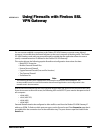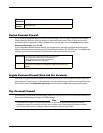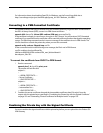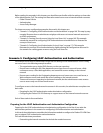
Unencrypting the Private Key
154 Firebox SSL VPN Gateway
12 Click Next to start the installation.
After Cygwin installs, you can generate the CSR.
These instructions to generate a CSR assume that you are using the Cygwin UNIX environment installed
as described in “To install Cygwin” on page 153.
To generate a CSR using the Cygwin UNIX environment
1 Double-click the Cygwin icon on the desktop.
A command window opens with a UNIX bash environment.
2 To change to a particular drive, use the command: cd driveLetter:
3 At the $ prompt, type the following to generate a CSR:
openssl req -new -nodes -keyout privateKeyFilename -out certRequestFilename
For example:
openssl req -new -nodes -keyout private.key -out public.csr
Status messages about the private key generation appear. You are prompted for information such
as country name.
4 When prompted for the Common name, enter the DNS name of the Firebox SSL VPN Gateway.
The name that you enter appears on the certificate and must match the name expected by
computers that connect to the Firebox SSL VPN Gateway. Thus, if you alias DNS names, you need to
use the alias name instead.
5 Submit your CSR (public.csr) to an authorized Certificate Authority such as Verisign. When asked for
the type of server that the certificate will be used with, select Apache.
Note
If you select “Microsoft,” the certificate might be in PKCS7 format and you will need to follow the
procedure in “Converting to a PEM-Formatted Certificate” on page 155 to convert the certificate to a
PEM format.
Unencrypting the Private Key
The following procedure is not needed if you use the Cygwin UNIX environment to generate the CSR
and private key. Follow this procedure only if the method you use to generate the private key results in
an encrypted key.
To unencrypt the private key
1 At the $ prompt enter the command: openssl rsa
If you enter this command without arguments, you are prompted as follows:
read RSA key
2 Enter the name of the password to be encrypted.
You can enter the openssl rsa command with arguments if you know the name of the private key
and the unencrypted PEM file.
For example, if the private key filename is my_keytag_key.pvk and the unencrypted filename is
keyout.pem, enter openssl rsa -in my_keytag_key.pvk -out keyout.pem.
For more information, see the Open SSL Web site at http://www.openssl.org/docs/apps/rsa.html#EXAM-
PLES.


















